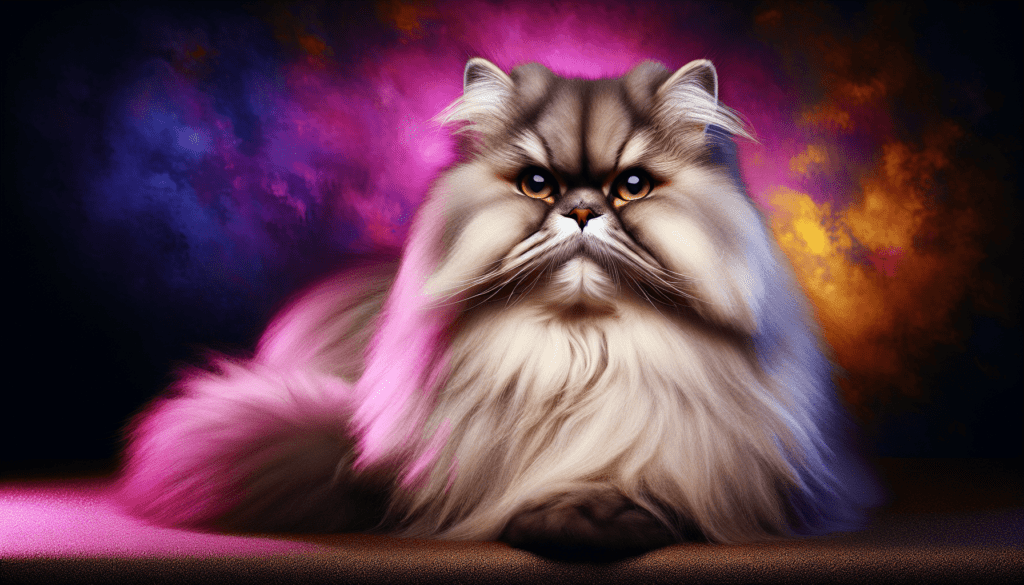If you’ve ever been mesmerized by the elegance and grace of a Persian cat, you may find yourself wondering about the secrets behind their mysterious behavior and unique characteristics. In “The Study of Persian Cats: Understanding Their Behavior and Characteristics,” we embark on a fascinating journey to delve into the enigmatic world of these captivating felines. From their calm temperament and luxurious coats to their independent nature and regal demeanor, this study aims to unravel the complexities of Persian cat behavior, shedding light on why they have become such beloved companions. So, prepare to be enchanted as we uncover the mysteries of the Persian cat and gain a deeper understanding of these beautiful creatures.

History of Persian Cats
Origins of Persian Cats
The history of Persian cats dates back thousands of years, with their origins traced to the region of Persia (modern-day Iran) in the Middle East. These beautiful felines are believed to have descended from the wildcats found in the mountainous areas of Persia. They were highly regarded and admired by nobility and royalty, who appreciated their luxurious appearance and gentle temperament.
Popularity and Spread
Over time, the popularity of Persian cats spread beyond their homeland. They captivated the hearts of cat lovers worldwide, resulting in their introduction to different countries and cultures. Traders and travelers played a significant role in the spread of Persian cats to various regions, including Europe and North America. Their intrinsic beauty and distinct personality contributed to their rise in popularity, making them one of the most cherished breeds in the world.
Recognition as a Breed
The Persian cat breed achieved formal recognition in the late 19th century. Cat fanciers and breeders began selectively breeding Persians to enhance their unique characteristics, such as their signature long, flowing coats and distinctive round faces. The efforts of dedicated breeders paid off, as the Persian cat breed gained recognition from cat registries and organizations, solidifying their status as a distinct and cherished breed within the feline community.
Physical Characteristics
Body Structure
Persian cats have a distinct body structure that sets them apart from other breeds. They have a medium-to-large-sized body with strong, muscular frames that give them an elegant and regal appearance. Their bodies are well-balanced, with a broad chest and a sturdy bone structure. Persians possess short legs and rounded, padded paws, which add to their overall charm.
Coat and Colors
One of the most captivating features of Persian cats is their luxurious coat. Their long, thick, and lustrous fur is a hallmark of the breed. Persian cats come in various coat colors and patterns, including solid, tabby, calico, tortoiseshell, and more. These stunning coat colors further enhance their regal and majestic demeanor, making them irresistible to cat enthusiasts.
Facial Features
The facial features of Persian cats are undoubtedly one of their most defining characteristics. They have round faces with large, expressive eyes that brim with curiosity and tranquility. Their eyes can be varying shades of blue, green, copper, or gold, adding depth and enchantment to their overall appearance. Persians also possess a well-developed nose with a gentle break, giving them a sweet and endearing expression that melts the hearts of those around them.
Temperament and Behavior
Gentle and Calm Nature
Persian cats are renowned for their gentle and calm nature, making them ideal companions for individuals seeking a peaceful and harmonious household. They are known to be passive and docile, preferring a serene and relaxed environment. Their soothing presence and tranquil disposition make them excellent pets for families, seniors, and individuals looking for a companion to destress and unwind with.
Sociability
While Persian cats enjoy a serene ambiance, they are also sociable creatures that appreciate human companionship. They form strong bonds with their owners and thrive on attention and affection. Persian cats love to curl up on their human’s laps for a cozy cuddle session or simply be in close proximity, soaking in the warmth and love they receive. They are intuitive animals that can sense and respond to their owner’s emotions, providing comfort and solace when needed.
Independence
Despite their affectionate and sociable nature, Persian cats also possess a degree of independence. They are content spending time alone and can entertain themselves with toys or quietly observe their surroundings. Persian cats enjoy their personal space and may retreat to a cozy corner or a favorite spot for some solitude. This trait makes them suitable for individuals who may not be able to spend all day attending to their feline companions.
Grooming Needs
Long Hair Maintenance
One of the essential aspects of caring for a Persian cat is their grooming needs, primarily due to their long and luxurious coats. Regular grooming sessions are crucial to prevent their fur from matting or tangling. Daily brushing is highly recommended to keep their coat soft, manageable, and free of pesky knots. It is essential to use a gentle brush or comb specifically designed for long-haired cats to ensure their comfort during grooming sessions.
Bathing and Brushing
In addition to daily brushing, Persian cats may require periodic baths to maintain the cleanliness and health of their coat. Baths should be given using cat-specific shampoos and warm water, ensuring a gentle and thorough cleanse. Regular brushing between baths helps to keep their coat healthy and free from debris. It is important to dry Persian cats thoroughly after bathing to prevent any skin irritation or discomfort.
Eye and Ear Cleaning
Persian cats have unique facial features, including their large, round eyes, which require regular attention. Their eyes may produce tears that can accumulate and cause staining or discomfort. Daily eye cleaning with a damp, soft cloth or specially formulated eye wipes is advised to maintain their eye hygiene. Similarly, their ears should be inspected weekly and cleaned using veterinarian-recommended ear cleaners to prevent wax buildup or infections.

Feeding Requirements
Nutritional Needs
Feeding Persian cats a nutritionally balanced diet is crucial for their overall health and well-being. A diet specifically formulated for their age and specific requirements is recommended. High-quality commercial cat food, whether wet or dry, should be the primary component of their diet. Consultation with a veterinarian can help determine the appropriate feeding plan to meet the unique dietary needs of Persian cats.
Portion Control
Maintaining an appropriate portion size is vital to prevent obesity, a common issue among Persian cats. Their sedentary nature and slower metabolism make them prone to weight gain. Feeding guidelines provided by the cat food manufacturer, based on the cat’s age, weight, and activity level, can help determine the right portion size. Regular monitoring of their weight and consultation with a veterinarian can help in adjusting the portion size if necessary.
Water Intake
Adequate hydration is essential for the overall health and well-being of Persian cats. Providing a clean and fresh water source at all times encourages them to drink enough water. Some Persian cats prefer moving water, which can be facilitated through the use of pet water fountains. Monitoring their water intake and ensuring they have easy access to water helps prevent dehydration and promotes a healthy urinary tract.
Health Concerns
Genetic Conditions
Like many purebred cats, Persian cats are prone to certain genetic conditions. Polycystic Kidney Disease (PKD) is one such condition commonly found in Persian cats, which can affect kidney function. Regular check-ups and screening tests can help identify and manage these genetic conditions. Responsible breeders perform genetic testing of their breeding stock to reduce the risk of passing on these conditions to their offspring.
Breathing Issues
Persian cats have unique facial structures that can contribute to breathing difficulties. Their short noses and flat faces, known as brachycephalic features, can lead to respiratory challenges. It is important to keep their environment free from irritants such as smoke, strong odors, or dusty environments that can exacerbate any breathing issues. Regular veterinary check-ups can help monitor and manage any respiratory concerns.
Dental Health
Dental care is crucial for Persian cats, as their facial structure can make them more prone to dental issues such as tooth decay, gingivitis, and periodontal disease. Daily tooth brushing with veterinarian-approved toothpaste and regular dental check-ups can help maintain their oral health. Additionally, providing dental treats or toys designed to promote dental hygiene can aid in keeping their teeth clean and their gums healthy.
Training and Enrichment
Basic Obedience Training
While Persian cats are generally independent, they can still benefit from basic obedience training. Training sessions can help establish communication between you and your feline companion, creating a stronger bond. Teaching basic commands such as “sit,” “stay,” or “come” can be accomplished through positive reinforcement techniques like treats or praise. Training sessions should be short and engaging to keep your Persian cat interested and motivated.
Interactive Toys and Games
To keep their minds stimulated and provide entertainment, Persian cats can benefit from interactive toys and games. Toys that encourage hunting instincts, such as puzzle toys or feather wands, can keep them mentally and physically active. Engaging in play sessions with your Persian cat not only provides them with exercise but also strengthens the bond between you and your furry friend.
Scratching Post Usage
Providing appropriate outlets for scratching is essential for Persian cats. They have a natural instinct to scratch and mark their territory. Investing in a sturdy scratching post or multiple scratching surfaces can help redirect their scratching behavior away from furniture or other undesirable areas. Rewarding them with treats or praise when they use the scratching post can reinforce positive and desirable scratching habits.
Living Environment
Indoor vs. Outdoor
Persian cats are generally better suited to an indoor living environment. Their luxurious coats require protection from the elements, and their gentle nature may make them more vulnerable to potential dangers outdoors. Providing an enriched indoor environment with access to windows, scratching posts, and stimulating toys can ensure they have a fulfilling and safe living space.
Creating a Safe Space
Creating a safe space within your home is important for Persian cats. They enjoy having their own designated area where they can retreat and relax. Providing cozy beds, blankets, or cat trees in quiet corners of your home can give them a sense of security and a space to call their own. Ensuring the safe space is away from high traffic areas and loud noises allows them to feel at ease and reduces stress.
Environmental Enrichment
Persian cats thrive in environments that offer mental and physical stimulation. Providing environmental enrichment through the use of interactive toys, scratching posts, and climbing structures can keep them entertained and engaged. Rotating toys and introducing new toys periodically prevents boredom and keeps their minds stimulated. Access to windows with a view of the outside world can also provide entertainment and mental stimulation for them.
Socialization and Interaction
Introducing to Other Pets
Introducing a Persian cat to other pets in the household requires careful consideration and gradual introductions. Patience is key when integrating Persian cats into a multi-pet household. Slowly exposing them to the scents and sounds of other animals and progressively allowing supervised interactions can help them acclimate and build positive relationships with their furry housemates.
Bonding with Humans
Persian cats form strong bonds with their human caregivers and appreciate affection and attention. Spending quality time with your Persian cat through petting, grooming, or simply engaging in play sessions can help foster a deeper bond between you. Creating a routine that includes regular one-on-one time strengthens the bond and ensures they feel loved and valued as a part of the family.
Handling and Petting
Gentle handling and petting techniques are essential when interacting with Persian cats. Their long coats and sensitive skin require a delicate touch to prevent discomfort or pain. Slow, deliberate movements and light strokes are generally well received by Persian cats. Paying attention to their body language and respecting their boundaries during handling ensures a positive and enjoyable experience for both you and your feline companion.
Selecting a Persian Cat
Choosing a Reputable Breeder
When selecting a Persian cat, it is crucial to choose a reputable breeder who prioritizes the health and well-being of their cats. Reputable breeders perform health checks, genetic testing, and socialization of their kittens. They provide proper documentation, such as pedigrees and vaccination records, and offer ongoing support and guidance to ensure the wellbeing of their cats.
Health Checks
Before bringing home a Persian cat, ensure they have undergone necessary health checks. This includes screening for genetic conditions, such as PKD, as well as general health examinations. Requesting health clearances and certificates from the breeder or veterinarian helps ensure you are obtaining a healthy and well-cared-for Persian cat.
Temperament Evaluation
Understanding the temperament of the Persian cat you are considering is important to ensure compatibility with your lifestyle and preferences. Interact with the kitten or cat you are interested in, observing their behavior and temperament. Reputable breeders often provide insight into each cat’s personality, allowing you to make an informed decision that matches your expectations and your cat’s needs.
In conclusion, studying Persian cats provides valuable insight into their behavior, characteristics, and care requirements. These majestic felines have a rich history and charm that continues to captivate cat lovers around the world. With their gentle temperament, stunning appearance, and unique needs, Persian cats make wonderful companions for those seeking a loving and tranquil addition to their lives.

